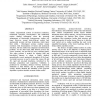Free Online Productivity Tools
i2Speak
i2Symbol
i2OCR
iTex2Img
iWeb2Print
iWeb2Shot
i2Type
iPdf2Split
iPdf2Merge
i2Bopomofo
i2Arabic
i2Style
i2Image
i2PDF
iLatex2Rtf
Sci2ools
ISBI
2007
IEEE
2007
IEEE
An Iterative Method for Registration of High-Resolution Cardiac Histoanatomical and Mri Images
Cardiac computational models of electrical conduction, mechanical activation, hemodynamics and metabolism require detailed information about the structural arrangement of functionally heterogeneous cardiac cell types. However, current state-of-the-art models lack anatomically accurate cell type localization, which limits their utility. Histological sections combine unique resolution with discrimination of tissues and anatomical structures, but they suffer from alignment and deformation problems. On the other hand, MRI datasets preserve the correct geometry, but provide less micro structural detail. This paper presents a method for aligning MRI and histological datasets to obtain a highly detailed, geometrically correct anatomical description of the heart. An iterative process is used to correct the various 2D and 3D, rigid and non-rigid transforms, introduced in the histology preparation and acquisition. Validation is performed by calculating distances between anatomical landmarks in ...
Cardiac Computational Models | Cell Type | Heterogeneous Cardiac Cell | ISBI 2007 | Medical Imaging |
| Added | 03 Jun 2010 |
| Updated | 03 Jun 2010 |
| Type | Conference |
| Year | 2007 |
| Where | ISBI |
| Authors | Tahier Mansoori, Gernot Plank, Rebecca Burton, Jürgen E. Schneider, Peter Kohl, David Gavaghan, Vicente Grau |
Comments (0)

